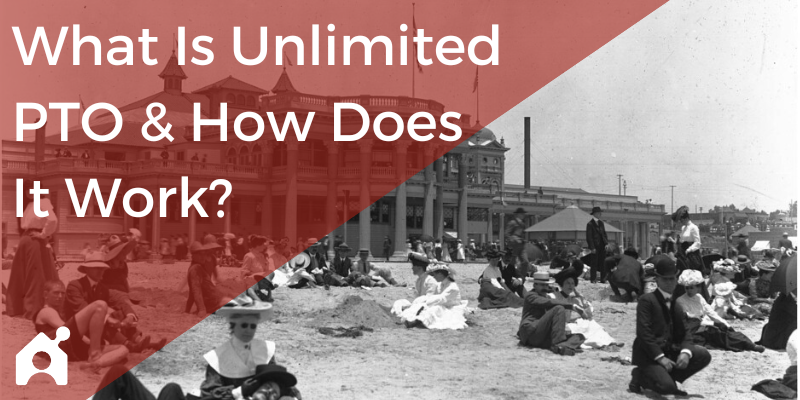What Is Unlimited PTO & How Does It Work?

In recent years, many companies have adopted unlimited PTO policies to compete for talent and appeal to prospective employees seeking a better work/life balance. But what exactly is unlimited PTO, and how does unlimited PTO really work?
Unlimited PTO sounds great, but there are some major drawbacks—significant enough that at the remote company I managed for six years, we ultimately rejected adoption of the unlimited PTO policy we had considered. I’ll cover those downsides in this article, while answering some of the basic questions about unlimited PTO:
- What is unlimited PTO and how does it work?
- What does unlimited PTO mean?
- How does unlimited PTO work for hourly employees?
- How does unlimited PTO work with FMLA (the Family Medical Leave Act)?
- How does unlimited PTO work with maternity leave?
What is unlimited PTO?
Unlimited PTO means “unlimited paid time off.”
The idea behind unlimited PTO policies is that they offer employees ultimate flexibility to take off as much time as they need or want (within reason). Many companies have adopted the policy to promote a culture of trust and empowerment—to communicate to employees that they are seen as responsible adults who can manage their own time effectively and do not need to have anyone else monitoring their schedule.
While unlimited PTO sounds great, there are some significant drawbacks that may not be apparent at first glance; I’ll sketch out some of the downsides in the following sections.
How does unlimited PTO work?
In theory, unlimited PTO allows employees to determine their own schedules and settle on the work/life balance that best suits their individual needs. But how does it work in the real world? What does “unlimited” time off mean in reality?
Because unlimited PTO policies have no set number of annual PTO days, paid time off is not tracked by HR as it is under a traditional system with a specified amount of PTO, so there is no draw down against PTO days. For HR, this eliminates a task and results in some time savings.
But even though HR isn’t tracking PTO, someone at the company still needs to know who’s working and who’s taking time off on any given day. Although employees can, in theory, take off as much time as they want or need, typically they will still need approval from a manager or team leader before taking days off. This is one of the points where the theory of how unlimited PTO works is at odds with the reality, as I’ll illustrate further in the next section.
See Also: Unlimited PTO Policy Examples & Templates
How does unlimited PTO really work?
In my opinion, unlimited PTO does not really work, for the following reasons:
- “Unlimited PTO” is a misnomer; there really is no such thing as “unlimited” PTO. An employee cannot take off 100% of the time and remain employed. Given that one of the main arguments in favor of unlimited PTO policies is fostering trust, it seems like a bad idea to start with false advertising.
- Time off is subject to approval. If the request runs counter to an important deadline, or the manager or team leader’s agenda or convenience, approval may not be granted—another example that what is called “unlimited time off” is not “unlimited” after all.
- Different managers may have different criteria for approving time off, which means the policy may not be equally applied throughout the company.
- There is a huge gray area in which the meaning of “unlimited” PTO can vary widely from one individual to another. The disconnect between the amount of time off an individual employee considers reasonable, and the amount of time off their manager or fellow team members may think is appropriate, can lead to discontent and resentment on the part of one or more parties.
- The disconnect regarding the meaning of unlimited PTO also exerts unspoken pressure on employees to adhere to the norm for their team—which can paradoxically result in employees taking fewer days off than they would under a traditional PTO system.
- Employees who voluntarily take fewer PTO days are essentially penalized with a lower effective hourly pay rate. Because there is no accrual of unused PTO days, employees will be due no compensation when they leave the company for the time they didn’t take off.
- Because there is no compensation for unused PTO, companies can use unlimited PTO policies to present a cost savings as an employee benefit.
For all of these reasons, what is presented as a benefit to employees is actually a benefit for the company. Not only does the company save some HR time by not tracking PTO; it also saves by not compensating employees for unused PTO. And because peer pressure within the organization is likely to dictate the “norm” for PTO, employees may take off less time than they would under a traditional PTO policy with a stipulated amount of PTO—meaning that employees may end up working more hours for a lower effective hourly rate—and have a less favorable work/life balance as well.
Unlimited PTO Questions & Answers
The following are some of the most frequently asked questions about unlimited PTO policies:
How does unlimited PTO work for hourly employees?
In short, it doesn’t. Hourly employees by definition are only paid for actual hours worked; for most hourly employees there is no paid time off at all, though there are exceptions where hourly workers accrue some amount of PTO each pay period.
On the flip side, hourly employees are entitled to overtime pay when they work more than 40 hours in any given week. Salaried employees are not eligible for overtime, and may end up working substantially more than 40 hours in a week during crunch times, without additional pay—but they receive compensation in the form of paid time off.
How does unlimited PTO work in California?
While there are quite a few California-based companies with unlimited PTO policies, the situation in the state is a bit trickier due to a recent (2020) California appeals court ruling, which held that under an employer’s unlimited PTO policy, an employee actually accrued vacation days as she worked and was entitled to be paid for unused days when her employment ended.
At issue in the case was the fact that the employer never notified the employee that her position was entitled to unlimited PTO. The court found that not all unlimited paid time off policies give rise to an obligation to pay for unused PTO when an employee leaves, provided that the policy:
- Clearly explains that employees’ ability to take paid time off is not a form of additional wages for services performed but is part of the employer’s promise to provide a flexible work schedule—including employees’ ability to decide when and how much time to take off.
- Spells out the rights and obligations of the employee and employer and the consequences of failing to schedule time off.
- Allows sufficient opportunity for employees to take time off or work fewer hours in lieu of taking time off.
- Is administered fairly so that it does not result in inequities, such as where one employee works many hours and takes minimal time off, and another works fewer hours and takes more time off.
While most of these factors are easy to address, the final one could pose problems for California companies with unlimited PTO policies, since it requires companies to ensure that there is equity in use of the benefit—which points in the direction of a more defined PTO policy with a stipulated minimum amount of PTO for all employees.
Companies in California which transition from a traditional PTO policy to unlimited PTO are also required by law to pay employees for accrued PTO when switching to the new policy.
There may also be conflict between unlimited PTO policies and California’s statutory medical leave act, the California Family Rights Act (CFRA), similar to the conflict between unlimited PTO and the federal Family Medical Leave Act (FMLA), as detailed in the answer to the next question.
How does unlimited PTO work with FMLA?
The intersection between unlimited PTO and the FMLA is blurry, and companies with unlimited PTO policies should take caution to avoid conflict between their leave policy and the FMLA. According to legal experts, even a cautiously-drafted policy spelling out that the unlimited PTO policy does not apply to FMLA-covered leave might not survive legal challenge.
The FMLA gives covered employees the right to take up to 12 weeks of unpaid leave for reasons related to family and medical events. FMLA applies to all public employers and private employers who have 50 or more employees. Duration of FMLA leave varies from case to case and depends on who is taking leave and why.
While family and medical leave have traditionally been unpaid in most cases, under an unlimited PTO policy, employees could be entitled to pay for the maximum 12 work weeks stipulated under FMLA. Many employers with unlimited PTO have eliminated any potential conflict by stipulating that under their leave policy, FMLA is paid leave as well.
So, what’s the best way to navigate conflict between FMLA and an unlimited PTO policy? Very carefully. To help companies with unlimited PTO policies avoid this pitfall, SHRM has compiled guidance for coordinating unlimited PTO with FMLA which may be helpful.
How does unlimited PTO work with maternity leave?
Since maternity leave is covered under FMLA, the same potential conflicts exist between unlimited PTO policies and maternity (and paternal) leave for employees covered by FMLA.
Some companies have chosen to simply include parental leave under their unlimited PTO policy, paying employees who are new parents for up to 12 weeks of time off (or more).
Companies that don’t intend to offer paid parental leave—or intend to offer paid parental leave of a shorter duration— should consult SHRM’s guidance for coordinating unlimited PTO with FMLA.
|
See Also: Unlimited PTO: The Complete Guide

 My Experience At A Company With Unlimited PTO
My Experience At A Company With Unlimited PTO